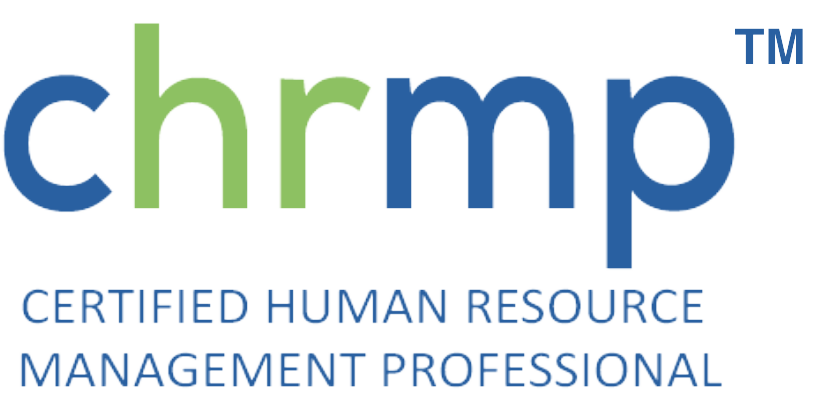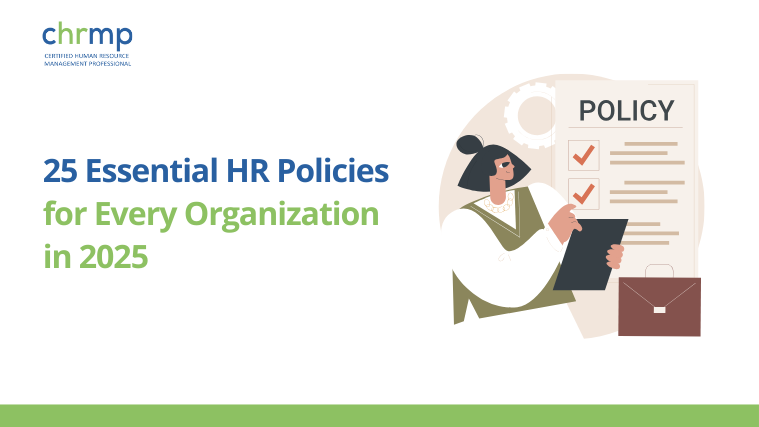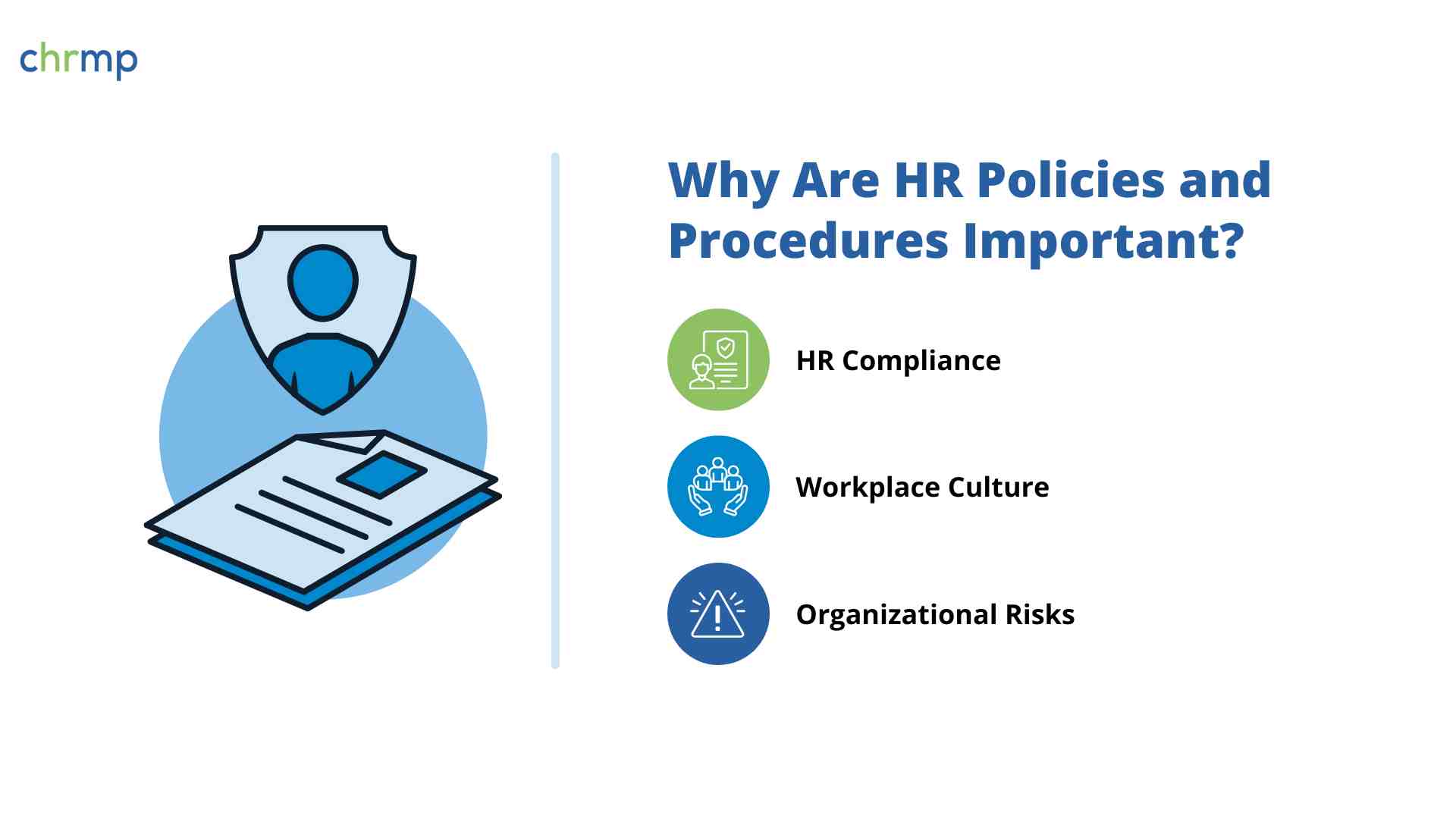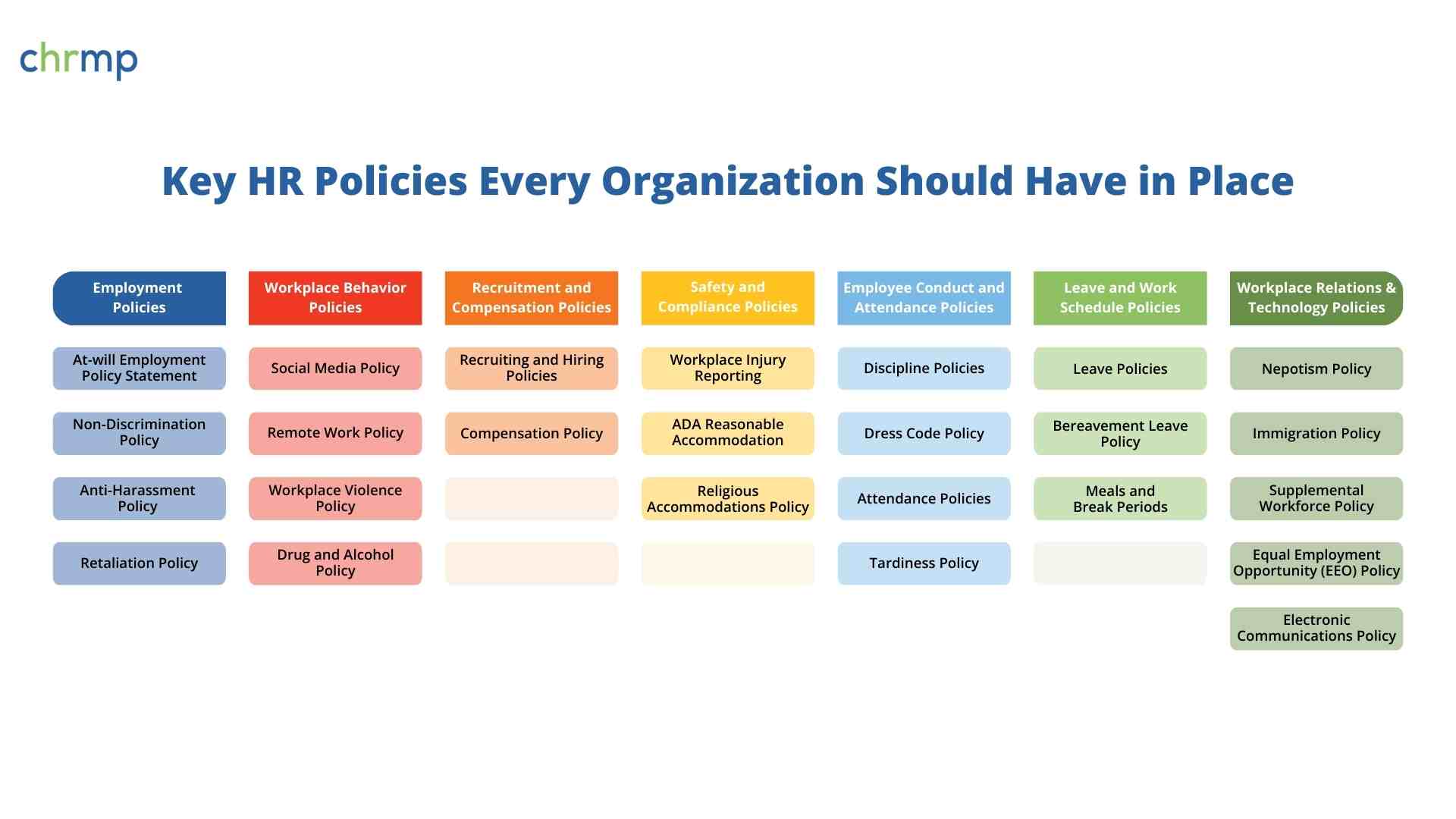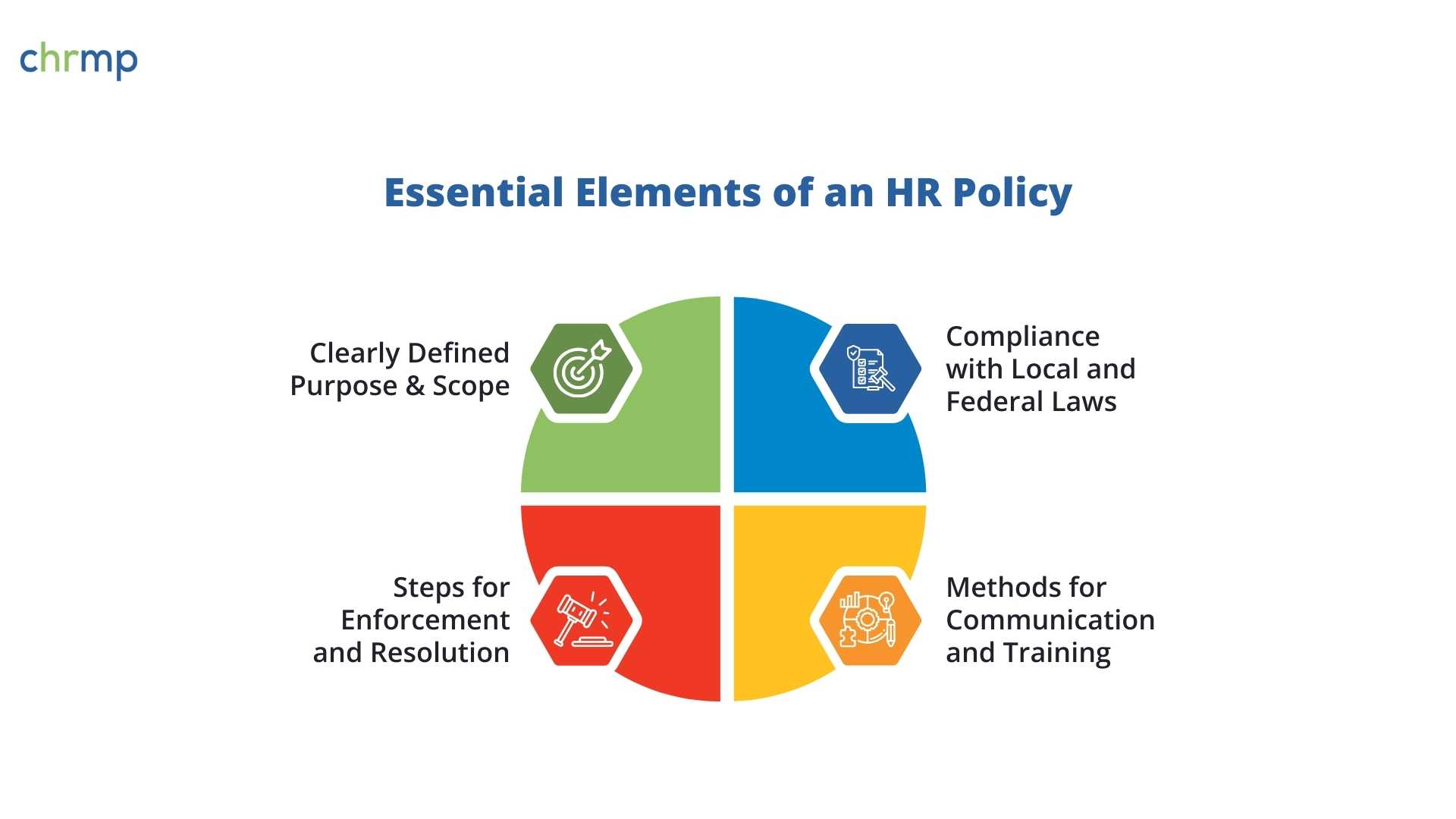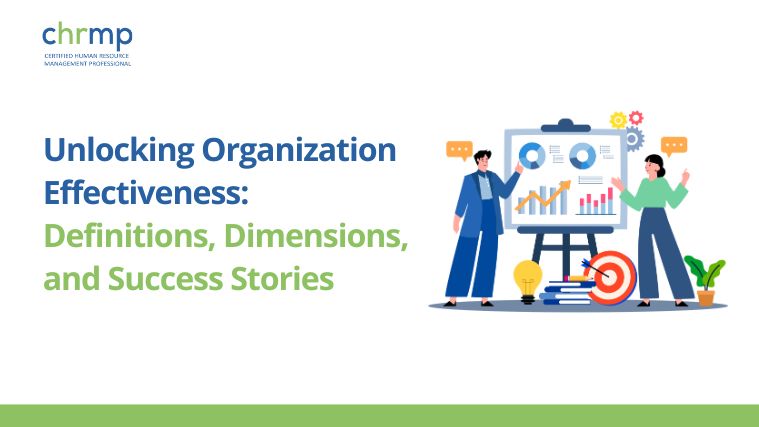Are outdated HR policies preventing your organization from thriving in today’s fast-paced environment? In this blog, we outline 25 key HR policies every organization needs to effectively navigate today’s dynamic workplace.
As organizations gear up for 2025, HR professionals face the challenge of balancing legal compliance, cultural expectations, and operational efficiency in an evolving workplace. Trends like remote work, diversity and inclusion initiatives, and advanced HR technologies are transforming the way businesses operate, presenting both hurdles and opportunities.
A 2023 Deloitte report reveals that 90% of organizations have updated their HR policies to adapt to these changes, highlighting the critical role of clear, modern guidelines.
Whether you’re a seasoned HR leader or just starting out, up-to-date HR policies are essential for building a compliant, engaged, and resilient workforce.
What Are HR Policies?
At their core, HR policies are formal guidelines that govern workplace behavior and operations. These policies serve as a roadmap for both employees and employers, setting clear expectations and standards that promote consistency and fairness across the organization.
HR Policy Definition
An HR policy definition encompasses the rules and procedures that guide employee actions and organizational processes. These policies cover everything from recruitment and compensation to workplace behavior and safety, ensuring that every aspect of the employee experience is managed effectively. For example, a Code of Conduct policy establishes the ethical standards and professional behavior expected from all employees, fostering a respectful and productive workplace environment.
HR Guidelines and Workplace Rules
HR guidelines are the actionable steps derived from these policies, providing detailed instructions on how to implement and adhere to the established rules. Workplace rules derived from HR policies ensure that all employees understand their roles, responsibilities, and the consequences of their actions, creating a structured and harmonious work environment.
Consider the Attendance Policy:
- Workplace Rule: Employees must be present and on time for their scheduled shifts. Excessive absenteeism or tardiness may result in disciplinary action, including warnings or termination.
- HR Guidelines: To effectively implement this rule, HR provides detailed instructions, such as:
- Attendance Tracking: Use time-tracking software to monitor attendance and punctuality.
- Reporting Absences: Employees must notify supervisors at least one hour before their shift starts using designated channels (e.g., company email or phone system).
- Documentation: Require valid documentation for absences exceeding three consecutive days, such as a doctor’s note.
- Disciplinary Procedures: Address attendance issues through a structured process, starting with verbal warnings, followed by written warnings, and potential termination for continued non-compliance.
- Support Programs: Offer assistance for employees facing personal challenges, including counseling services and flexible scheduling options.
- Incentives for Good Attendance: Implement recognition programs or rewards for employees with exemplary attendance records to encourage punctuality and reliability.
- Policy Communication: Conduct regular training sessions and distribute the Attendance Policy to ensure all employees understand the expectations and procedures.
In this example:
- The workplace rule sets the overarching expectation regarding attendance.
- The HR guidelines provide specific steps to enforce the rule, ensuring clarity and consistency in its application.
Why Are HR Policies and Procedures Important?
Understanding the importance of HR policies is crucial for maintaining a healthy and legally compliant workplace. Here’s why they matter:
HR Compliance
HR policies ensure that your organization complies with local, state, and federal regulations, thereby mitigating potential legal risks. By adhering to these guidelines, you safeguard your organization against lawsuits and penalties that could arise from non-compliance.
Workplace Culture
Effective HR policies play a pivotal role in shaping a positive workplace culture. They promote fairness, consistency, and transparency, which in turn enhance employee satisfaction and retention. A well-defined policy framework fosters an environment where employees feel valued and respected, driving overall organizational success.
Organizational Risks
By setting clear expectations and procedures, HR policies help in identifying and mitigating organizational risks. Whether it’s addressing workplace harassment or ensuring data security, these policies provide a structured approach to handling potential challenges, thereby safeguarding the organization’s reputation and operational integrity. A robust Workplace Violence Policy can help prevent incidents and ensure swift, appropriate responses if they occur, reducing the likelihood of costly disruptions and enhancing employee safety.
25 HR Policies Every Organization Should Have in Place
Establishing essential HR policies is fundamental to creating a well-functioning workplace. Here are 25 critical policies that every organization should consider implementing:
Employment Policies
1. At-will Employment Policy Statement: Clarifies the nature of the employment relationship, emphasizing that either party can terminate the employment at any time, with or without cause.
2. Non-Discrimination Policy: Ensures equal opportunities for all employees, prohibiting discrimination based on race, gender, age, religion, or other protected characteristics.
3. Anti-Harassment Policy: Defines unacceptable behaviors and outlines procedures for reporting and addressing harassment in the workplace.
4. Retaliation Policy: Protects employees who report misconduct or participate in investigations from any form of retaliation. This policy encourages employees to speak up without fear, fostering a transparent and safe work environment.
Workplace Behavior Policies
5. Social Media Policy: Provides guidelines for employees’ online behavior and brand representation, balancing personal expression with professional responsibility. This ensures that all digital interactions uphold the company’s reputation.
6. Remote Work Policy: Sets standards for productivity, communication, and accountability in remote or hybrid work settings. This includes expectations for availability, performance metrics, and communication protocols.
7. Workplace Violence Policy: Outlines procedures to handle threats or incidents of violence, ensuring a safe work environment for all employees. This includes reporting mechanisms and response strategies.
8. Drug and Alcohol Policy: Establishes rules for maintaining a substance-free workplace, including testing and consequences for violations. This policy helps ensure safety and compliance with industry regulations.
Recruitment and Compensation Policies
9. Recruiting and Hiring Policies: Ensures fair and unbiased hiring practices, promoting diversity and merit-based recruitment. This includes standardized interview processes and criteria-based selection.
10. Compensation Policy: Outlines the organization’s salary structure, pay practices, and benefits, ensuring competitive and equitable remuneration. This policy supports employee satisfaction and retention by offering fair compensation.
Safety and Compliance Policies
11. Workplace Injury Reporting: Details the steps employees must take to report and document any workplace injuries, ensuring prompt and proper handling. This helps in compliance with occupational safety regulations.
12. ADA Reasonable Accommodation: Ensures accessibility for employees with disabilities, outlining the process for requesting and providing necessary accommodations. This promotes an inclusive workplace.
13. Religious Accommodations Policy: Supports employees’ religious practices by allowing reasonable adjustments to work schedules or duties. This fosters respect for diverse religious needs within the organization. For instance, a global non-profit organization may offer flexible prayer breaks and holiday observances to accommodate diverse religious needs.
Employee Conduct and Attendance Policies
14. Discipline Policies: Establishes rules for addressing employee misconduct, including progressive disciplinary actions and termination procedures. This maintains order and performance standards.
15. Dress Code Policy: Sets expectations for appropriate workplace attire, aligning with the organization’s culture and operational needs. This ensures a professional and cohesive appearance among employees.
16.Attendance Policies: Tracks and manages employee punctuality and attendance, outlining expectations and consequences for absenteeism. This policy supports operational efficiency and reliability.
17. Tardiness Policy: Addresses late arrivals, detailing the associated consequences and steps for improvement. This helps maintain punctuality and accountability.
Leave and Work Schedule Policies
18. Leave Policies: Includes provisions for sick leave, vacation, personal days, and other types of time off, ensuring employees can balance work and personal life. This promotes employee well-being and work-life balance.
19. Bereavement Leave Policy: Provides time off for grieving employees to cope with the loss of a loved one. This supports employees during difficult times, enhancing their emotional well-being.
20. Meals and Break Periods: Outlines rest and meal break entitlements, ensuring employees have adequate time to recharge during work hours. This helps maintain productivity and employee health.
Workplace Relations and Technology Policies
At-will Employment Policy Statement
21. Nepotism Policy: Prevents favoritism in hiring and promotions by setting clear guidelines on family relationships within the workplace. This ensures fairness and objectivity in employment decisions.
22. Immigration Policy: Covers procedures for hiring foreign nationals, ensuring compliance with immigration laws and regulations. This supports the recruitment of global talent while adhering to legal requirements.
23. Supplemental Workforce Policy: Provides guidelines for managing temporary staff, including contractors and freelancers, ensuring they adhere to organizational standards. This facilitates seamless integration of supplemental workers into projects.
24. Equal Employment Opportunity (EEO) Policy: Ensures equal opportunities for all employees, reinforcing the organization’s commitment to diversity and inclusion. This policy supports a diverse and dynamic workforce.
25. Electronic Communications Policy: Governs the use of company devices and emails, setting standards for professional communication and data security. This protects sensitive information and maintains professional standards in digital interactions.
How to Develop HR Policies
Creating effective HR policies requires a strategic approach that aligns with your organization’s goals and complies with legal requirements. Here’s how to develop comprehensive HR policies:
Essential Elements of an HR Policy
- Clearly Defined Purpose and Scope
- Each policy should have a clear objective and define who it applies to within the organization. For example, a Remote Work Policy should specify eligibility, expectations, and procedures for all remote employees.
- Compliance with Local and Federal Laws
- Ensure that all policies adhere to relevant laws and regulations to avoid legal complications. Regular consultation with legal experts can help keep policies up-to-date with changing laws.
- Steps for Enforcement and Resolution
- Outline the procedures for enforcing the policies and resolving any disputes or violations that arise. A Discipline Policy should detail the steps from verbal warnings to termination.
- Methods for Communication and Training
- Develop strategies to effectively communicate the policies to all employees and provide necessary training to ensure understanding and compliance. Interactive training sessions and easily accessible policy documents can enhance comprehension and adherence.Key Takeaways
- Clarity and Conciseness: Policies must be written in a clear, concise manner to ensure they are easily understood by all employees.
- Consistency in Enforcement: Consistently enforcing policies is crucial to maintaining fairness and credibility.
- Regular Updates: Regularly review and update policies to reflect legal changes and evolving workplace dynamics.
- Develop strategies to effectively communicate the policies to all employees and provide necessary training to ensure understanding and compliance. Interactive training sessions and easily accessible policy documents can enhance comprehension and adherence.Key Takeaways
Conclusion
In the dynamic landscape of 2025, having well-crafted HR policies is essential for any organization aiming to thrive. These policies not only ensure legal compliance and risk management but also foster a positive and inclusive workplace culture. By implementing the 25 essential HR policies outlined above, you can create a structured environment that supports both organizational goals and employee well-being.
Call to Action
Ready to elevate your HR practices? Start by reviewing your current HR policies and identify areas for improvement. For more insights and expert guidance, consider partnering with a certified HR professional or enrolling in advanced HR certification programs. Empower your organization with the right policies today for a successful tomorrow.
FAQs:
1. What is the purpose of HR policies and procedures?
HR policies and procedures provide a structured framework that guides employee behavior and organizational operations. They set clear expectations, ensure compliance with legal standards, and promote a fair and consistent workplace environment. For example, a Non-Discrimination Policy ensures all hiring practices are unbiased, fostering a diverse and inclusive workforce.
2. What are the key HR policies organizations should have in 2025?
In 2025, organizations should prioritize policies related to remote work, diversity, equity, and inclusion (DEI), workplace safety, data privacy, and employee well-being. Additionally, policies addressing technological advancements and flexible work arrangements are increasingly important. For instance, a Data Privacy Policy is crucial as companies handle more sensitive employee and customer information.
3. How do HR policies support compliance and risk management?
HR policies ensure that the organization adheres to legal regulations, thereby mitigating the risk of lawsuits and penalties. They also provide clear guidelines for handling various workplace scenarios, reducing the likelihood of misconduct and enhancing overall organizational stability. A Workplace Safety Policy not only complies with OSHA standards but also minimizes the risk of workplace accidents.
4. What are the steps to create effective HR policies?
Creating effective HR policies involves:
- Identifying organizational needs.
- Researching legal requirements.
- Drafting clear and concise policies.
- Seeking feedback from stakeholders.
- Implementing comprehensive training programs to ensure understanding and compliance.
For example, developing a Remote Work Policy would start with understanding the specific needs of your workforce, followed by researching best practices and legal considerations related to remote employment.
5. How often should HR policies be updated?
HR policies should be reviewed and updated at least annually or whenever there are significant changes in laws, regulations, or organizational structures. Regular updates ensure that policies remain relevant and effective in addressing current workplace challenges. For example, updates to the ADA Reasonable Accommodation policy might be necessary to reflect new accessibility technologies .
6. What role does HR play in enforcing workplace policies?
HR is responsible for implementing, monitoring, and enforcing workplace policies. This includes training employees, addressing violations, and ensuring that policies are applied consistently across the organization. For instance, HR teams conduct regular training sessions on the Anti-Harassment Policy to ensure all employees understand the guidelines and reporting procedures.
7. How do policies like remote work or social media affect workplace culture?
Policies on remote work and social media establish clear expectations and boundaries, fostering a culture of trust and professionalism. These policies help maintain productivity, protect the organization’s reputation, and ensure that employees feel supported and valued in their roles. For example, a well-crafted Remote Work Policy can enhance work-life balance, leading to higher employee satisfaction and retention.
8. What is the difference between policies and procedures in HR?
Policies are overarching guidelines that set the framework for organizational behavior and decision-making, while procedures are the specific steps or actions required to implement these policies. In essence, policies define the “what” and “why,” whereas procedures outline the “how.” For example, a Compensation Policy sets the standards for salary structures, while the Salary Review Procedure details the steps managers must take to evaluate and adjust salaries .
9. How can HR ensure employee buy-in for new policies?
HR can ensure employee buy-in by:
- Involving employees in the policy development process.
- Clearly communicating the benefits and rationale behind the policies.
- Providing comprehensive training.
- Being open to feedback and adjustments based on employee input.
For instance, when introducing a Flexible Work Schedule Policy, HR might conduct surveys to understand employee preferences and incorporate their feedback into the final policy, ensuring it meets the workforce’s needs.
10. What are the challenges in implementing and maintaining HR policies?
Challenges include:
- Ensuring compliance with constantly changing laws.
- Addressing diverse employee needs.
- Overcoming resistance to change.
- Maintaining consistency in enforcement across different departments and locations.
For example, implementing a Diversity and Inclusion Policy may face resistance if not adequately communicated or if employees do not see tangible support from leadership. Continuous training and leadership endorsement are essential to overcome these challenges.
